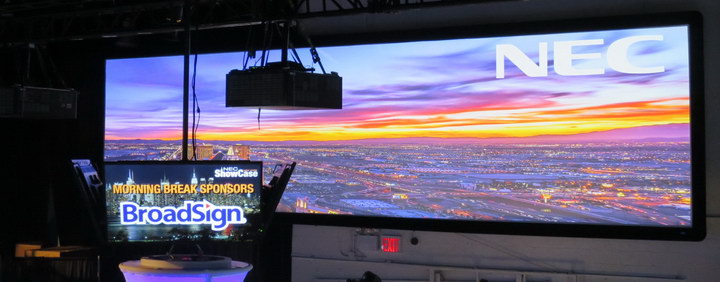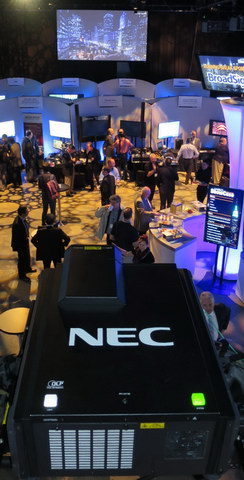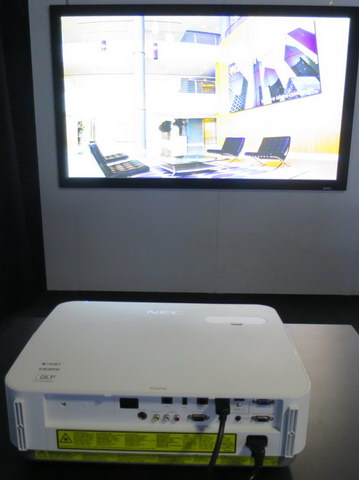At the NEC Showcase last week in New York, I had a chance to talk to Rich McPherson, Senior Product Manager, Projectors, about the latest laser-phosphor projectors from NEC. Most of these projectors were on display and operating.
He told me that, in the future, NEC expects that NEC projectors over about 5,000 lumens will be laser-phosphor rather than lamp-based. One of the main reasons a customer will chose a laser phosphor projector over a lamp projector is because of the much, much longer life of the light source. Typically it is 20,000 hours at full-power in the normal mode and significantly longer in the Eco mode, although McPherson didn’t want to see a specific Eco mode lifetime number in print.
Not surprisingly, McPherson said all NEC projectors with solid state lighting (SSL) were DLP based, some single chip and some three chip. He said that the single chip versions use one bank of blue lasers and a phosphor wheel with a yellow phosphor. The same blue lasers both excite the phosphor and generate the blue light in the image. The yellow light is filtered to generate the green and red light for the image.
The three-chip projectors actually use two banks of blue lasers, one to excite a yellow phosphor and a second to generate the blue light for the image. The yellow light is then split into red and green to illuminate the red and green DLP imagers.
At lower lumen levels, the price difference between lamp-based and laser phosphor-based projectors can be important to customers. This is coupled with the fact that advances in lower power UHP-type mercury lamps has given them much longer lifetimes. For some customers, the 5K – 8K hour life available from lamps is long enough and the projectors become functionally obsolete before there is a need to replace the lamp.
Projectors on display at the NEC showcase included:
PX803UL is a single chip projector with 8K lumen output. McPherson says this is the first laser-phosphor single DLP projector in this lumen category from any vendor. It has WUXGA (1920 x 1200) resolution and an OPS slot for an embedded computer. The OPS slot is especially useful for digital signage applications. The light source is expected to last for 20K hours at maximum power.
 The main image at the NEC Showcase was generated by a blend of three PH1202HL projectors. One of these projectors is shown in silhouette against the image and a second is barely visible in the dark to the left. Blending was done with Scalable software.
The main image at the NEC Showcase was generated by a blend of three PH1202HL projectors. One of these projectors is shown in silhouette against the image and a second is barely visible in the dark to the left. Blending was done with Scalable software.
PH1202HL is a three-chip projector with 1080p resolution. This projector has been formally introduced as a product but is not yet shipping. List price for the projector is $59,999. Three of these projectors were blended to generate the main image at the Showcase.
 The PH1201QL on display used a very long throw ratio projection lens to generate an image on the far side of the Showcase room. Standing on the floor 10 feet (3M) or more from the image made it impossible to appreciate the 4K resolution.
The PH1201QL on display used a very long throw ratio projection lens to generate an image on the far side of the Showcase room. Standing on the floor 10 feet (3M) or more from the image made it impossible to appreciate the 4K resolution.
PH1201QL (right) is a three chip projector with native 4K resolution (4096 x 2160). This projector does not contain an OPS slot. The list price on this projector is $149,999 and it is shipping now. The unit on display was an early unit and is limited to 30Hz content. McPherson said that all units shipped to customers will accept 60Hz content. This was the only projector I saw at the NEC showcase without a HDBaseT input. Instead, it had an HDMI input capable of handing the 4K 60Hz content.
 The P502HL and the image it generated. This projector was shown side-by-side with the P502H with the same content.
The P502HL and the image it generated. This projector was shown side-by-side with the P502H with the same content.
P502H and P502HL (left) are nearly identical 5,000 lumen 1080p projectors with different light sources that were introduced on November 1st. The difference is that the P502H has a lamp and the P502HL has a laser phosphor light source. The two projectors have different form factors due to the differing cooling requirements for lamps and laser-phosphor systems but have identical electronics. Both projectors have H/V lens shift, HDBaseT and dual HDMI inputs.
At the request of customers, NEC has included a second LAN port on these projectors for control. This avoids the need to route control signals through the special switchers required for HDBaseT. According to McPherson, the P502HL is priced at $4,599. While the PH502H version of the projector has not been priced yet, McPherson expects it to be just over half of the price of the P502HL version.
According to McPherson, all NEC laser-phosphor projectors have a 3 year, 12,000 hour warranty. The NEC showcase was targeted primarily at NEC’s digital signage customers and other installation applications. This class of users is very happy to get a long warranty. Detailed specifications and price information on all NEC multimedia projectors is available at http://www.necdisplay.com/category/multimedia-projectors. –Matthew Brennesholtz

